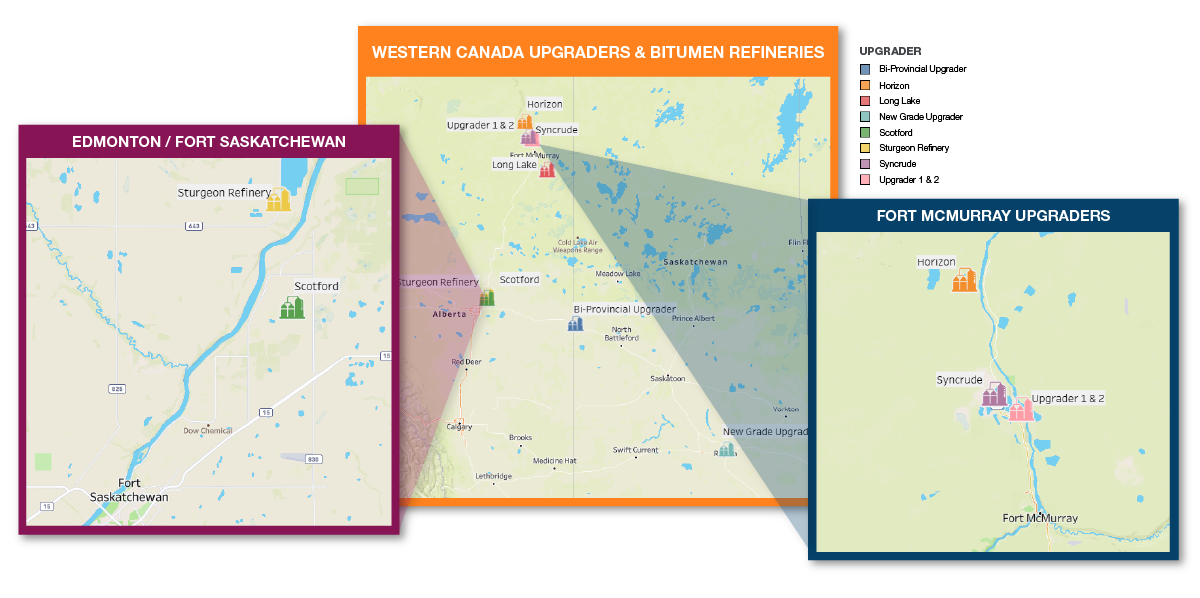Market Snapshot: A tour of Canada’s oil sands upgraders
Connect/Contact Us
Please send comments, questions, or suggestions for Market Snapshot topics to snapshots@cer-rec.gc.ca
Release date: 2022-02-23
Bitumen or crude bitumen is a thick, sticky form of crude oil. When extracted from the ground, bitumen has the consistency of peanut butter and is too thick to be transported by pipeline. Therefore, it is either upgradedDefinition* to a lighter synthetic crude oilDefinition* (SCO) or diluted with a light hydrocarbon-like condensate (referred to as diluted bitumen or “dilbit”Definition*). SCO has an advantage when compared to heavy conventional oil or diluted bitumen as it is easier to refine, because it does not require expensiveDefinition* facilities to convert it into light products like gasoline, jet fuel, or diesel.
Bitumen can be upgraded by either removing carbon from the bitumen (cokingDefinition*) or by adding hydrogen (hydroconversionDefinition*). An upgrader using coking technology has a lower capital cost than one using hydroconversion,Footnote 1 but the total yield of SCO will be lower (80 - 90% of bitumen processed). Hydroconversion, however, offers a better yield (100% or more) because of the hydrogen addition.Footnote 2
In 2020, there were four active upgradersDefinition* in Alberta and two in Saskatchewan, with a total SCO capacity of 223.8 thousand cubic meters per day (1 407.5 thousand barrels per day (10³ bbl/d)). The same year, Alberta upgraders processed 42% of the 3.0 million barrels per day of bitumen produced in the province, yielding 1.1 million barrels per day of SCO.Footnote 3
Figure 1: Western Canada’s upgraders and bitumen refineries

| Upgrader | Company | Location | Province | Status | SCO Capacity | |
|---|---|---|---|---|---|---|
| (10³m³/d) | (10³bbl/d) | |||||
| Horizon | Canadian Natural Resources Limited (CNRL) | Near Ft. McMurray | AB | Active | 39.7 | 250.0 |
| Scotford | Shell Canada | Scotford | AB | Active | 50.9 | 320.0 |
| Upgrader 1 & 2 | Suncor Energy | Near Ft. McMurray | AB | Active | 56.8 | 357.0 |
| Syncrude | Syncrude Energy | Mildred Lake | AB | Active | 55.6 | 350.0 |
| New Grade Upgrader | CO-OP | Regina | SK | Active | 7.8 | 49.0 |
| Bi-Provincial Upgrader | Husky Energy | Lloydminster | SK | Active | 13.0 | 81.5 |
| Active Upgraders Capacity | ||
|---|---|---|
| Alberta | 203.0 | 1 277.0 |
| Saskatchewan | 20.7 | 130.5 |
| Western Canada | 223.8 | 1 407.5 |
Bitumen Refineries
| Refinery | Company | Location | Province | Status | Refined Products Output | |
|---|---|---|---|---|---|---|
| (10³m³/d) | (10³bbl/d) | |||||
| Sturgeon | North West Redwater Partnership | Sturgeon County | AB | Active | 7.9 | 50.0 |
Source and Description
Source: Oil Sands Magazine
Description: This map shows the location of the bitumen upgraders and the bitumen refinery in western Canada. The attached table provides information (name, owner, and capacity) of each upgrader and bitumen refinery.
The attached table includes information on the existing upgraders (Horizon, Scotford, Suncor Upgraders 1 & 2, Syncrude, and Long Lake in Alberta; New Grade Upgrader, and Bi-Provincial Upgrader in Saskatchewan; and the Sturgeon bitumen refinery in Alberta. Details of the table include the facility name, company/operator, location, status of operation, and SCO capacity in thousands of cubic metres day (10³m³/d) and thousands of barrels per day (10³bbl/d). Subtotals of capacity for the existing upgraders is provided by province and for the entire western Canada region. The bitumen refining capacity is not subtotaled, as the Sturgeon refinery in Alberta is the only one, and it produces refined products rather than SCO. The 9.3 Th. m³/d (58.5 10³bbl/d) CNOOC (ex-Nexen) Long Lake upgrader was shut down in early 2016 after a fire damaged the facility and was not included.
The Bi-Provincial Upgrader in Lloydminster, Saskatchewan, and New Grade Upgrader in Regina, Saskatchewan, are integrated with the Lloydminster and Regina refineries,Definition* respectively. The Scotford upgrader in Alberta is also integrated with the Scotford refinery. The North West Redwater Partnership’s bitumen refinery in Sturgeon County, Alberta, is currently licensed as an upgrader, but it operates as a refinery, producing refined petroleum products.
Upgrading was used to commercialize the oil sands when it started production in the late 1960s, because there was no other way to transport bitumen to markets. However, skyrocketing upgrader capital costs and shrinking light-heavy oil differentials from the late 2010s onwards (due mostly to the shale oil revolution), made it difficult to build new upgraders, and only expansions of existing facilities have been completed . New technologies to process and dilute bitumen for pipeline transportation have also made upgrading bitumen optional. Today, the economics of building (or expanding an existing upgrader) depends now on the price differential between West Texas Intermediate (WTI)Definition* and Western Canadian Select (WCS),Definition* as synthetic crude oil (SCO) is tied to WTI and the value of bitumen is now linked to WCS and diluent prices in Alberta.
- Date modified:
